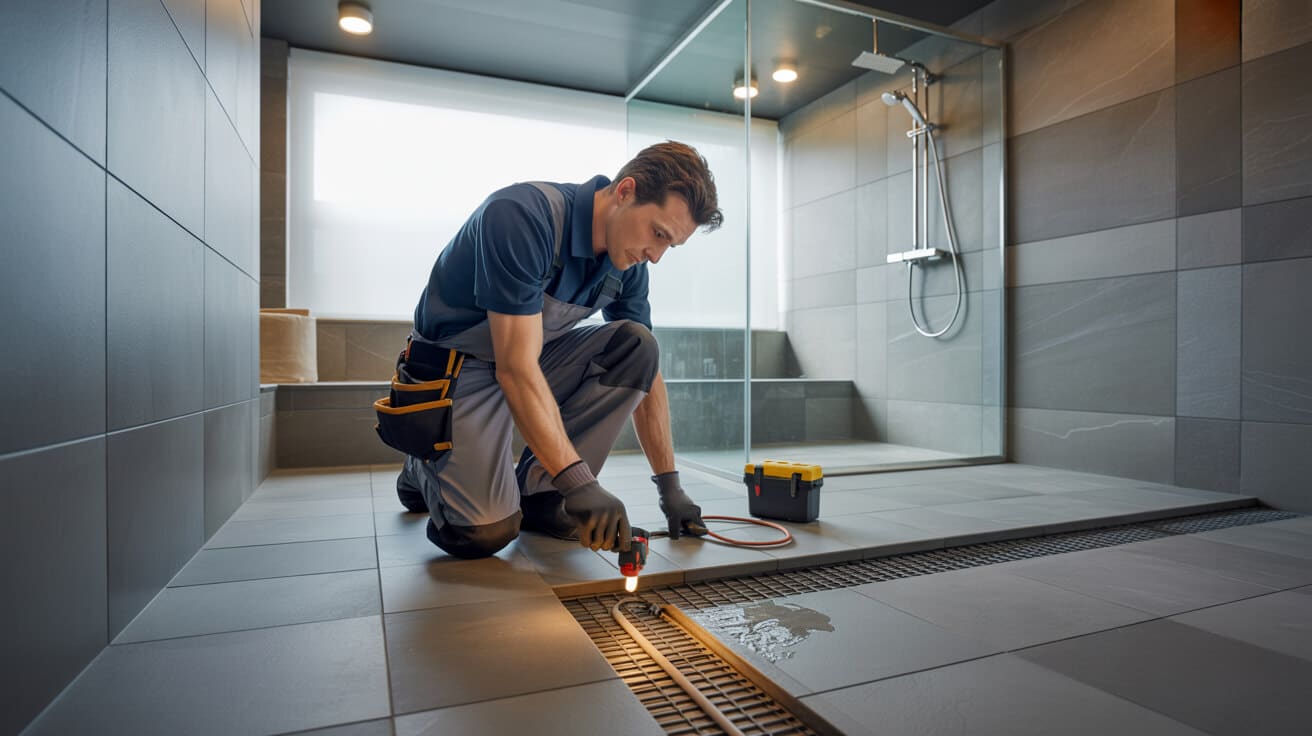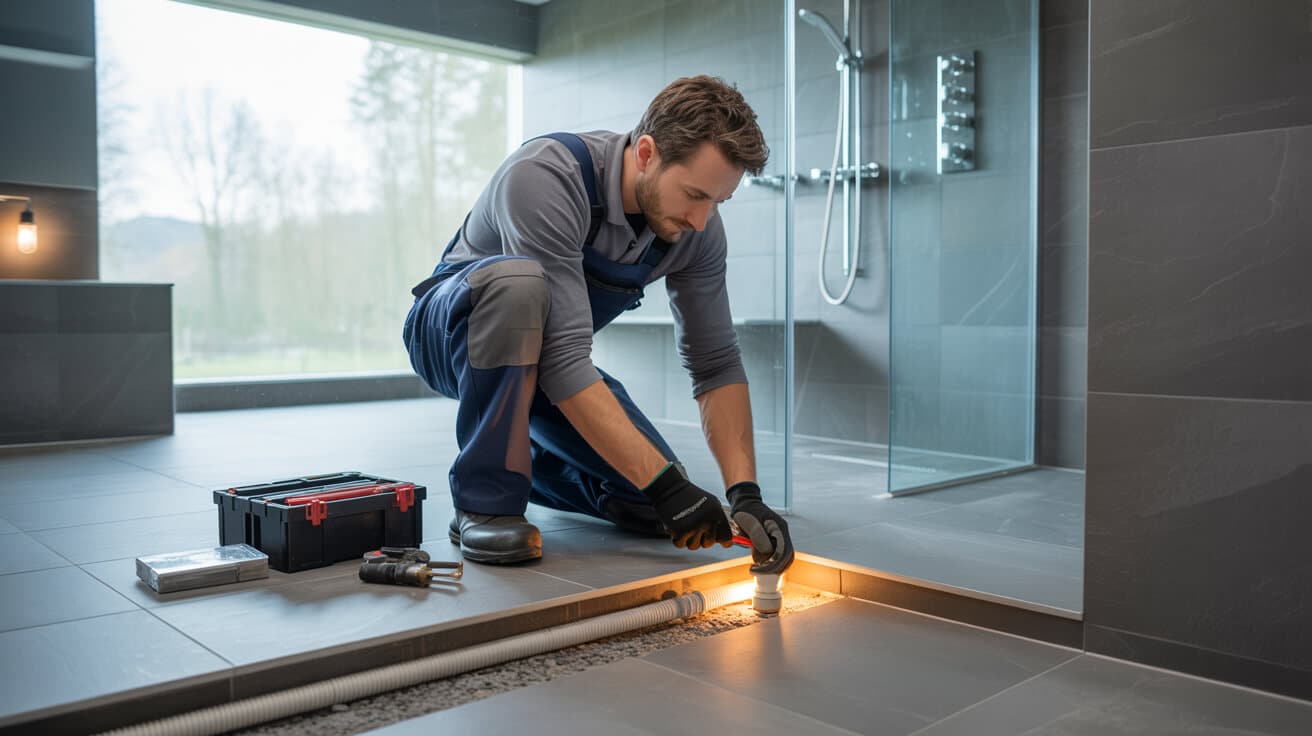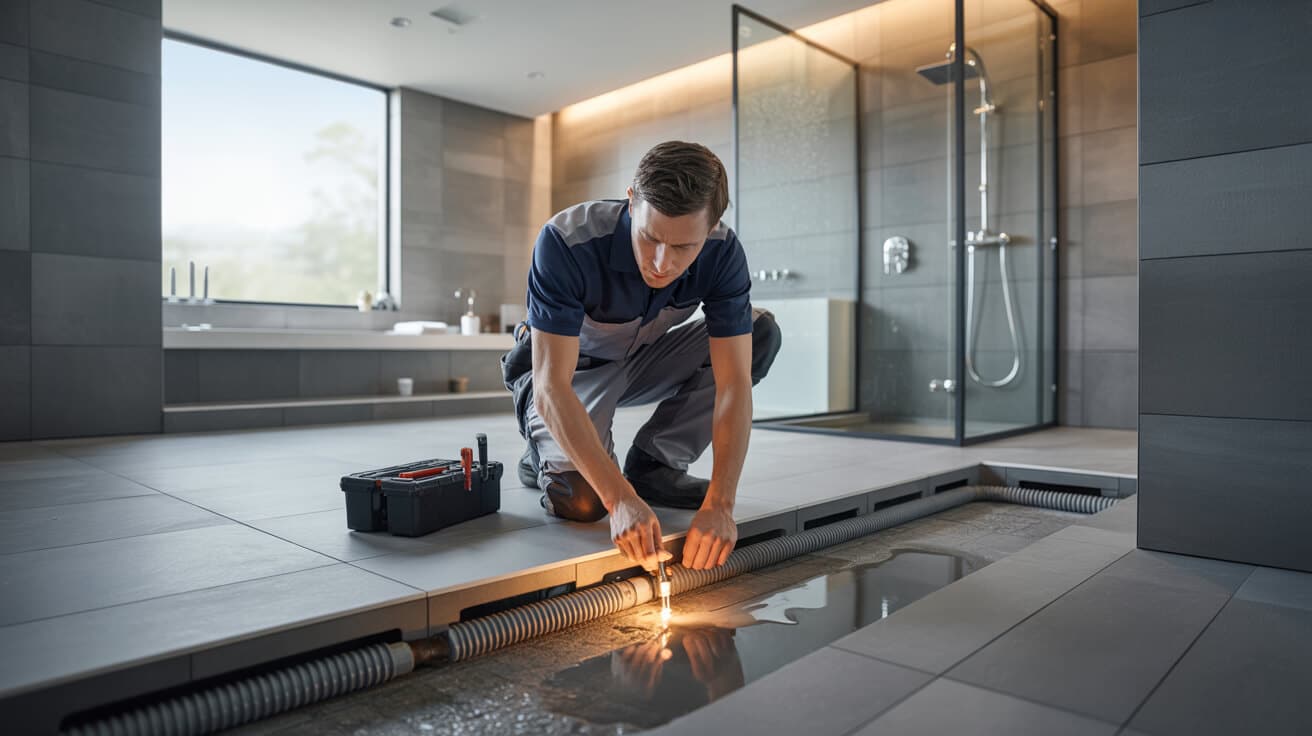hydronic underfloor heating systems operate through warm water circulated by an array of pipes beneath finished flooring, delivering even heat and space-saving comfort. Leaks within these concealed loops are rare yet consequential, as delayed detection can escalate to significant water damage, heat waste, and costly floor restoration. Effective management of such occurrences involves sophisticated diagnostics, minimally invasive repair, and robust documentation—often delivered by qualified plumbing and heating firms, including recognised providers such as Plumbers 4U. The strategic coordination between technical expertise, regulatory expectations, and transparent client communication sets the foundation for responsive and lasting leak remediation.
Etymology or name origin
The word “underfloor” derives from the physical installation of heating components below the finished flooring surface. “Hydronic” stems from the Greek word “hydor,” meaning water, combined with engineering jargon for closed-loop circulation. “Pipe leak repair” unifies plumbing terminology for identifying and restoring the integrity of pressurised water conveyance systems. Together, these terms form a precise descriptor for a plumbing specialty whose complexity has grown alongside advances in floor construction, insulation, and system controls.
Overview and context
Adoption in modern construction
Underfloor heating has become a preferred solution in both newly constructed and retrofitted properties. Builders favour these systems for their unobtrusive delivery of warmth, compatibility with contemporary design demands, and ability to integrate with renewable energy sources. In large domestic dwellings, luxury flats, hotels, and commercial environments, the discrete placement of heating loops beneath tiles, wood, or composite floors maximises interior space utility.
Types of heating systems in use
The two dominant forms of underfloor heating are water-based (hydronic) and electric. Hydronic types circulate heated water from boilers, heat pumps, or renewable sources, making them a focus for leak detection and repair protocols. Electric systems, by contrast, employ resistive cables and tend not to present the same leak risks.
Concealment and detection challenges
While floor-embedded design enhances aesthetics and safety, it complicates maintenance. Leaks often remain hidden until symptoms such as pressure drops, cold spots, or dampness signal a problem. The need for specialised, non-destructive diagnostics arises from the costs and disruptions associated with invasive floor access.
Plumbing and heating industry role
Qualified plumbing and heating specialists—often called upon during both commissioning and repair—must combine advanced detection technologies, deep product knowledge, and adherence to health and safety regulations. Their work not only restores performance but also protects your property from escalating water damage and system degradation.
History
Ancient thermal systems and hypocausts
Underfloor heat distribution originated with Roman and Korean hypocaust mechanisms, employing subfloor channels for smoke or heated air. These systems established the principles of radiant floor heating, although their scale and fuel options differed from modern hydronic arrangements.
Post-war innovations
Post-World War II reconstruction prompted experimentation with plastic and metal piping for heating applications in Western Europe, particularly in energy-conscious markets. Early installations demonstrated the need for precise pipe materials and layout geometry, constraints addressed by evolving engineering standards.
Advances in materials and leak detection
The widespread adoption of cross-linked polyethylene (PEX), polybutylene (PB), and multilayer composite (MLCP) piping improved resilience to mechanical and chemical stresses. Leak detection historically depended on invasive floor removal or observable surface damage, but improvements in thermal imaging and acoustic technologies have made repair less disruptive.
Recent regulatory and environmental evolution
Environmental targets have encouraged adoption of underfloor heating in low-carbon building programmes, but also introduced stricter expectations for efficiency, documentation, and water conservation. Accreditation for installers and periodic maintenance—ensured by companies like Plumbers 4U—has become a norm, driven by both market and legal incentives.

Concept and description
System composition
A standard hydronic underfloor heating circuit includes a network of flexible polymer or composite pipes arranged in looped patterns, radiant heat-insulating layers, a flow management manifold, zone-based thermostats, and a screed or floating subfloor. Water is circulated under low to moderate pressure, distributing energy evenly across zones.
Mechanics of heat transfer and pressure
Thermal energy is transferred via conduction from pipe to floor surface before radiating upward into the occupied space. The closed hydraulic loop ensures stable pressure and efficient temperature control. Loss of pressure, air ingress, or pipe rupture directly undermines heating efficacy.
Leak pathways and failure modes
Leaks most commonly result from three mechanisms:
- Mechanical penetration (nails, screws, or drilling during subsequent renovations)
- Material degradation (UV exposure pre-installation, chemical incompatibility, or incorrect bend radius)
- Fittings or joint failures at the manifold or coupler sites, especially where incompatible materials or thermal cycling are factors
Inspection and diagnosis logic map
Diagnosis incorporates your observed symptoms—such as localised cold spots, unexpected boiler cycling, or visible damp—alongside technical evidence: static pressure loss, thermal anomalies, and changes in system responsiveness. Visual confirmation may follow advanced detection to minimise unnecessary floor removal.
Functionality, purpose, and applications
Energy efficiency and comfort
Hydronic underfloor heating offers enhanced energy distribution at lower operational temperatures, harnessing increased surface area and radiative heating for improved sensory comfort. The system integrates seamlessly with gas boilers, heat pumps, and solar thermal installations, supporting both traditional and sustainability-oriented buildings.
System resilience and safety practices
Resilient system design depends on compliant materials, skilled installation, and regular maintenance. Firms such as Plumbers 4U use annual servicing and asset audits to identify early-stage issues, ensuring that leaks or performance drops are detected before substantial floor or property damage results.
Common building types and use cases
Your organisation may find underfloor heating in high-end residential, commercial, healthcare, and hospitality settings, as well as in large open-plan spaces where wall-mounted radiators are impractical. Its aesthetic and ergonomic benefits are balanced by the technical demands of maintenance and repair.
Maintenance dependencies
Routine care includes monitoring gauge pressures, annual balancing and flushing, system inspections for leaks (visual and technological), and timely response to household or business user complaints. Insurers and landlords often mandate a documented maintenance regime for coverage protection.
Classifications and system types
Pipe materials
- PEX (Cross-Linked Polyethylene): Resilient, flexible, and energy-efficient; most commonly specified for new builds and compatible with majority of push-fit or press-fit couplings.
- MLCP (Multilayer Composite Pipe): Consists of interleaved polymer and aluminium layers; valued for increased mechanical strength and lower thermal memory.
- PB (Polybutylene): Less common in recent installations due to material weaknesses identified in some legacy systems.
- Copper: Rarely used now due to cost, inflexibility, and corrosion potential in concealed environments.
Subfloor structures
- Screed: Dense sand-cement layer embedding pipework, providing thermal stability but complicating post-installation access.
- Timber Batten or Floating Floor: Offers ease of access but weaker thermal transfer; often found in lightweight or modular buildings.
- Overlay Panels: Thin-profile, retrofit-friendly systems favoured for minimal disruption but requiring careful compatibility with floor coverings.
System variants
- Hydronic: The standard for energy efficiency and wide-scale commercial or domestic use; integrates with renewable heating sources.
- Electric: Cable- or mat-based, easier to instal for small areas but not prone to hydraulic leaks; when faults occur, thermal imaging or resistance testing is used in place of moisture detection.
Manufacturer variants, standards, and certifications
Regulatory bodies including WRAS and standards such as BS EN 1264 govern approved product lists and installation protocols. Plumbers 4U and similar providers maintain partnership networks with leading brands to assure repair part compatibility and preserve warranty status.
Detection and repair methods
Stepwise approach to leak identification
Leak diagnosis and repair follow a structured process: 1. Symptom assessment: Incidents of unexplained pressure drop, uneven heating, or visible surface moisture are logged and prioritised. 2. Preliminary isolation: The affected heating circuit is isolated for targeted testing, minimising system disruption. 3. Non-invasive detection: Use of thermal cameras, tracer gas, and acoustic tools pinpoints leak location before floor access. Moisture metres confirm water presence in subfloor strata.
Professional detection technologies
- Thermal imaging: Detects cold “shadows” produced by water loss; effective for both screed and timber assemblies.
- Tracer gas: Inert gas introduced into the pipe network escapes through leaks and is detected above the floor with a sniffer, precisely locating even pinhole breaches.
- Acoustic sensors: Sensitive microphones “hear” the telltale frequencies of escaping water, filtered to distinguish from background noise.
- Inspection endoscopes: Inserted into small access holes, providing direct visualisation.
Minimal access techniques
Data from detection tools enables precise floor cutting, reducing your exposure to unnecessary disturbance. Plumbers 4U employs microdust systems and advanced blades to preserve your floor’s structural and aesthetic qualities.
Pipe repair workflow
- Exposure: Accurate removal of floor covering and substrate reveals the damaged pipe section.
- Isolation and draining: Water is evacuated from the circuit; adjacent pipes are protected to prevent collateral movement.
- Section removal: The defective section is excised with a pipe cutter.
- Installation of couplers: Compatible push-fit or press-fit couplings are fit to join new and existing pipe, with PTFE or equivalent seals.
- Testing and recommissioning: Following mechanical restoration, the system is refilled, pressurised, and bled of air. A staged temperature ramp restores service, with final infrared or acoustic validation.
Floor/fabric restoration
Restoration materials are matched to existing screed or overlay properties, with rapid-curing compounds reducing your downtime. Surface finishes are returned to original standards when possible—a critical factor for aesthetic and insurance outcomes.
Documentation and client explanation
Detailed logs—including date, area, method, materials, and photographic flow—are maintained for records and future auditing. Plumbers 4U informs you of restoration details, remaining risk, and any follow-up required as part of your ongoing asset stewardship.

Tools, equipment, and consumables
Diagnostic devices
- Thermal imaging cameras:
- Tracer gas kits:
- Acoustic microphones:
- Moisture metres:
- Pressure gauges:
- Borescope/endoscopes:
These devices support leak confirmation before structural exposure, dramatically reducing unnecessary invasive work.
Repair tools
- Pipe cutters and shears:
- Crimping/press-fit connection tools:
- Microdust extraction blades:
- Hand tools for controlled floor access:
Consumables and repair parts
- Push-fit or press-fit pipe couplers:
- Pipe support inserts:
- PTFE tape and sealing compounds:
- Screed repair mortar:
- WRAS-approved insulation:
Manufacturer compatibility
Plumbers 4U and similar providers maintain inventory and procurement channels for system-specific spares, ensuring your repairs uphold manufacturer warranties and regulatory expectations.
Stakeholders and roles
Technical professionals
- Engineers and system designers: Specify repair approach, select compatible parts.
- Installers and detection technicians: Conduct day-to-day fieldwork, maintain compliance documentation.
- Flooring specialists: Restore floor finishes to original state post-repair.
Industry bodies and regulatory agencies
Bodies such as WRAS, BESA, and local building control direct standards for installation, ongoing maintenance, and repair practices. These ensure your repair meets both safety and legal requirements.
Property owners and managers
Owners, landlords, and property managers must act promptly on reported or detected leaks to reduce long-term costs, comply with insurance, and uphold occupant safety.
Manufacturers and suppliers
Pipe, fitting, and equipment suppliers provide documentation, warranties, and technical support crucial for long-term system viability and claim validation.
Insurance and warranty actors
Insurers expect rapid notification, verifiable repair evidence, and ongoing risk management. Failure to comply can result in denied claims or policy revisions, enhancing the value of meticulous asset records for your organisation.
Legal, regulatory, and ethical considerations
Building Regulations
UK Building Regulations Part L and G apply to energy efficiency and sanitation, respectively, requiring that licenced professionals handle repairs and that the works be fully documented.
WRAS compliance
All pipe and fitting replacements must comply with Water Regulations Advisory Scheme standards to preserve potable water safety and system reliability.
Documentation and compliance
For landlords, property managers, and organisations, maintaining up-to-date repair logs, product certification, and insurance claims processing is as vital as the repair itself.
Risk assessment and method statements
Before intrusive work, RAMS are created to assure safety for your premises, the technicians, and adjacent building assets.
Warranty management
Repairs maintain or reinstate warranty status if compatible parts and methods are used; property records are updated accordingly.
Insurance
Complete, timely documentation is essential for later insurance claim success—especially in business, institutional, or managed residential situations.
Performance metrics, data, and validation
Pressure and thermal benchmarks
Technicians record baseline and post-repair circuit pressures, balancing and flow rates, and implement thermal imaging for newly serviced areas to establish success or identify residual anomalies.
Audit reporting
Results, including test data, photos, and step diagrams, form a permanent record for your asset management and future insurance needs.
Moisture and subfloor condition metrics
Where moisture metres detect elevated values, technicians document and monitor until readings return to safe parameters.
Asset register protocols
For commercial or institutional properties, asset management includes not only repair logs but also long-term lifecycle cost data and maintenance history.
Challenges, barriers, and limitations
Diagnostic complexity
Multi-layer floors, novel substrates, or past undocumented repairs can thwart rapid identification.
Disruption and inconvenience
Areas under repair may be unavailable for hours or days, requiring temporary accommodation. Sensitive floor finishes or historic assets accentuate risk during access.
Economic and insurance issues
Absence of warranties, complex insurance exclusions, and post-repair increased premiums may affect both owner and tenant.
Technical knowledge demand
Successful repairs demand specialised knowledge and are not guaranteed by generic property maintenance skillsets.
Recurrence and asset depreciation
Unresolved leaks or incomplete repairs can reoccur, sometimes reducing property values or leading to expensive litigation in leasehold or managed portfolios.
Impact, influence, and legacy
Effects on property and occupant experience
Rapid and effective leak repair preserves your property integrity, supports healthy indoor environments, and stabilises long-term costs.
Environmental and sustainability factors
Repairing leaks maintains water and energy efficiency, supporting building environmental objectives and national sustainability targets.
Building management best practices
Continual evolution of diagnostics, documentation, and compliance has improved overall sector performance and strengthened outcomes for stakeholders at all levels.
Value realisation for diverse users
Homeowners, businesses, landlords, and public organisations benefit from professional repair, compliant documentation, and organised maintenance, reinforcing both short-term asset value and long-term viability.
Future directions, cultural relevance, and design discourse
Innovations in detection and prevention
Research into smart sensors, improved pipe composites, and automated monitoring promises earlier and more targeted interventions. The future may see predictive leak alerts built into system control panels.
Material science and durability
Advancement in material durability—both for pipes and insulation—aims to reduce leak frequency and repair requirements for the next generation of buildings.
Regulatory trends and best practice adoption
Anticipated tightening of building and water safety standards will increase demand for continual professional development among technicians and greater transparency for property owners.
Professional and consumer education
As systems grow more sophisticated, professional qualifications, end-user education, and transparency in servicing will become a market differentiator.
Sociocultural relevance
Media depictions and rising expectations of invisible comfort, minimal disruption, and guaranteed safety have made underfloor heating a marker of modern living—embedding its reliability and repair in household and institutional consciousness.

